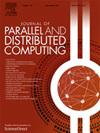Optimizing parallel heterogeneous system efficiency: Dynamic task graph adaptation with recursive tasks
IF 4
3区 计算机科学
Q1 COMPUTER SCIENCE, THEORY & METHODS
引用次数: 0
Abstract
Task-based programming models are currently an ample trend to leverage heterogeneous parallel systems in a productive way (OpenACC, Kokkos, Legion, OmpSs, PaRSEC, StarPU, XKaapi, ...). Among these models, the Sequential Task Flow (STF) model is widely embraced (PaRSEC's DTD, OmpSs, StarPU) since it allows to express task graphs naturally through a sequential-looking submission of tasks, and tasks dependencies are inferred automatically. However, STF is limited to task graphs with task sizes that are fixed at submission, posing a challenge in determining the optimal task granularity. Notably, in heterogeneous systems, the optimal task size varies across different processing units, so a single task size would not fit all units. StarPU's recursive tasks allow graphs with several task granularities by turning some tasks into sub-graphs dynamically at runtime. The decision to transform these tasks into sub-graphs is decided by a StarPU component called the Splitter. After deciding to transform some tasks, classical scheduling approaches are used, making this component generic, and orthogonal to the scheduler. In this paper, we propose a new policy for the Splitter, which is designed for heterogeneous platforms, that relies on linear programming aimed at minimizing execution time and maximizing resource utilization. This results in a dynamic well-balanced set comprising both small tasks to fill multiple CPU cores, and large tasks for efficient execution on accelerators like GPU devices. We then present an experimental evaluation showing that just-in-time adaptations of the task graph lead to improved performance across various dense linear algebra algorithms.
优化并行异构系统效率:递归任务的动态任务图自适应
基于任务的编程模型目前是一种以生产方式利用异构并行系统的充分趋势(OpenACC、Kokkos、Legion、omps、PaRSEC、StarPU、XKaapi等)。在这些模型中,顺序任务流(Sequential Task Flow, STF)模型被广泛采用(PaRSEC的DTD、omps、StarPU),因为它允许通过看起来顺序的任务提交自然地表示任务图,并且自动推断任务依赖关系。然而,STF仅限于在提交时具有固定任务大小的任务图,这在确定最佳任务粒度方面提出了挑战。值得注意的是,在异构系统中,最佳任务大小因不同的处理单元而异,因此单一任务大小不适合所有单元。StarPU的递归任务通过在运行时动态地将一些任务转换为子图,从而允许具有多个任务粒度的图。将这些任务转换为子图的决策是由称为Splitter的StarPU组件决定的。在决定转换某些任务之后,将使用经典调度方法,使该组件具有通用性,并且与调度程序正交。在本文中,我们提出了一种新的Splitter策略,该策略是为异构平台设计的,它依赖于旨在最小化执行时间和最大化资源利用率的线性规划。这将产生一个动态平衡的集合,其中既包括填充多个CPU内核的小任务,也包括在GPU设备等加速器上高效执行的大任务。然后,我们提出了一个实验评估,表明任务图的即时适应可以提高各种密集线性代数算法的性能。
本文章由计算机程序翻译,如有差异,请以英文原文为准。
求助全文
约1分钟内获得全文
求助全文
来源期刊

Journal of Parallel and Distributed Computing
工程技术-计算机:理论方法
CiteScore
10.30
自引率
2.60%
发文量
172
审稿时长
12 months
期刊介绍:
This international journal is directed to researchers, engineers, educators, managers, programmers, and users of computers who have particular interests in parallel processing and/or distributed computing.
The Journal of Parallel and Distributed Computing publishes original research papers and timely review articles on the theory, design, evaluation, and use of parallel and/or distributed computing systems. The journal also features special issues on these topics; again covering the full range from the design to the use of our targeted systems.
 求助内容:
求助内容: 应助结果提醒方式:
应助结果提醒方式:


